Reclamation Works: New and recent films by William E. Jones and Thom Andersen
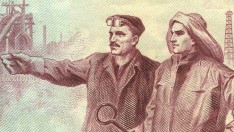
Model Workers, by William E. Jones
Los Angeles Filmforum presents
Reclamation Works: New and recent films by William E. Jones and Thom Andersen
Sunday July 26, 2015, 7:30 pm
At the Spielberg Theatre at the Egyptian, 6712 Hollywood Blvd., Los Angeles CA 90028
William E. Jones and Thom Andersen in person! One U.S and five Los Angeles premieres!
In what promises to be a superb evening, William E. Jones and Thom Andersen each return to Filmforum to present recent works that look deep into past films to find or revitalize their meanings. Whether social investigation, political commentary, or a new-forgotten filmmaker’s documentation of an era largely forgotten, these two artists again show why they are two of the finest cinema makers of today. Five works by William E. Jones include one U.S. and four Los Angeles premieres, and Thom Andersen’s Juke is its local premiere.
For more event information: www.lafilmforum.org, or 323-377-7238
Tickets: $10 general, $6 students/seniors; free for Filmforum members. Available by credit card in advance from Brown Paper Tickets at http://bpt.me/2005522 or at the door.
William E. Jones is an artist and filmmaker born in Canton, Ohio. His works include Massillon (1991) and Finished (1997), The Fall of Communism as Seen in Gay Pornography (1998), Is It Really So Strange? (2004), and many other films and videos that have been shown internationally. In recent years he has turned to writing; his books include “Killed”: Rejected Images of the Farm Security Administration (2010), Halsted Plays Himself (2011), Imitation of Christ (2013), Flesh and the Cosmos (2014), and the forthcoming True Homosexual Experiences: Boyd McDonald and Straight to Hell. He lives in Los Angeles. http://www.williamejones.com/
Thom Andersen has lived in Los Angeles for most of his life. In the 1960s, he made short films, including Melting (1965), Olivia’s Place (1966), and --- ------- (1967, with Malcolm Brodwick). In 1974 he completed Eadweard Muybridge, Zoopraxographer, an hour-long documentary film about Muybridge’s photographic work. It was restored by the UCLA Film and Television Archive in 2013. In 1995, with Noël Burch, he completed Red Hollywood, a critical video essay about the film works created by the victims of the Hollywood Blacklist. Their work on the history of the Blacklist also produced a book, Les Communistes de Hollywood: Autre chose que des martyrs, published in 1994.
In 2003 he completed Los Angeles Plays Itself, a three hour-long movie about the representation of Los Angeles in movies. It was voted one of the 50 best documentaries ever made in a Sight&Sound critics’ poll. In 2010, he completed Get Out of the Car, a short 16mm portrait of Los Angeles. In 2012, he directed Reconversão, an HD video about the work of Portuguese architect Eduard Souto Moura, the winner of Pritzker Prize in 2011. He has taught at the California Institute of the Arts since 1987. He screened his latest feature film, The Thoughts That Once They Had, at Filmforum in April 2015.
---------------
This program is supported by the Los Angeles County Board of Supervisors through the Los Angeles County Arts Commission; the Department of Cultural Affairs, City of Los Angeles; Bloomberg Philanthropies; and the Mike Kelley Foundation for the Arts. Additional support generously provided by American Cinematheque. We also depend on our members, ticket buyers, and individual donors.
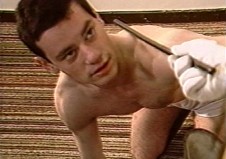
Midcentury
Midcentury
By William E. Jones (30:00, video, color, sound, 2012) *U.S. premiere
Midcentury is a compilation originally commissioned for the 53rd Venice Biennale (2009), reworked once for the 57th Oberhausen Film Festival (2011), then again for an exhibition at White Cube in London (2012). Its form mimics that of a network’s broadcast day, condensed to a half hour. Although Midcentury contains no first person narration, it can be considered an autobiography of sorts—the work of a hyperactive child who grew up in an industrial wasteland during the Cold War and watched far too much television.
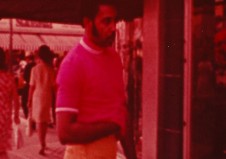
Shoot Don’t Shoot
Shoot Don’t Shoot
By William E. Jones (2012, video, color, sound, 4:30) *Los Angeles premiere
Shoot Don’t Shoot adapts a 1970s law enforcement instructional film that trains officers to decide by instinct whether or not to fire their guns. The suspect in this sequence fits the following description: “a black man wearing a pinkish shirt and yellow pants.”
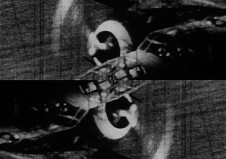
Bay of Pigs
Bay of Pigs
By William E. Jones (2012, video, black and white, sound, 3:55) *Los Angeles premiere
Bay of Pigs makes use of a “captured” film from the CIA Film Library, Girón, a production of El Instituto Cubano del Arte e Industria Cinematographicos documenting the aerial bombardment of la Batalla de la Playa Girón, or as it is known in the United States, the Bay of Pigs Invasion. The soundtrack comes from a numbers station called “Atención” after the first word announcing the shortwave radio broadcast. All governments have denied the existence of numbers stations, as well as their purpose, espionage. An FBI arrest in 1998 of suspects involved in broadcasting coded messages from Florida to Cuba led to the only public acknowledgment of this phenomenon.
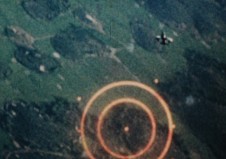
Actual TV Picture
Actual TV Picture
By William E. Jones (2013, video, color, sound, 7:09) *Los Angeles premiere
Actual T. V. Picture juxtaposes footage of a jungle in Viet Nam being bombed by an American war plane with a late-1960s television commercial showing recent advancements in miniature transistors. This technology made possible improvements in consumer goods like television sets, but its origin was in military weaponry, as the advertisement shows. The color of the original films has not been altered. Images of the former material are predominantly green; the latter, faded to red, as virtually all Eastmancolor film stock manufactured in the 1960s and 70s has or will. The soundtrack comes from shortwave radio broadcasts that the government of Viet Nam interrupted with harsh, discordant frequencies. They have been carefully edited in an elaborate mix that sounds a bit like techno music. The film was finished on the 40th anniversary of the Paris Peace Accords, the treaty that officially ended the United States’s direct military involvement in the Viet Nam War.
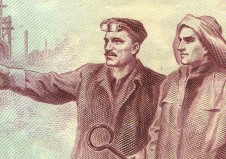
Model Workers
Model Workers
By William E. Jones (2014, high definition video, color, silent, 12:16) *Los Angeles premiere
Model Workers presents a collection of paper money bearing images of workers. Intricately engraved details are arranged in chronological order; full views of the banknotes are in reverse chronological order, ending at the beginning: Mexico, 1914. The montage includes colonies and the independent countries they became, as well as former and present socialist states. Workers from Africa, the Americas, Asia, and Europe are represented. Only the world’s biggest capitalist powers—United States, Japan, United Kingdom, and the recently unified Eurozone—are missing. They do not acknowledge the source of their wealth on their currency.
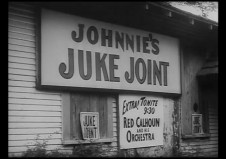
Juke: Passages from the Films of Spencer Williams
Juke: Passages from the Films of Spencer Williams
By Thom Andersen (2015, 29 min.) *Los Angeles premiere!
“During the 1940s, Spencer Williams directed nine race films for Sack Entertainment in central Texas, and he acted in eight of these films. Six of these films exist today.
“In Juke, I attempt to reclaim his work, to demonstrate its originality and beauty as well as its documentary value. Williams returns always to the same theme: the struggle between the sacred and the profane, the church and the juke joint, gospel and blues. He portrays both with equal conviction. The church always prevails, but he gives the devil his due. That’s what makes The Blood of Jesus a masterpiece: it takes a miracle to bring her back from the allure of the city and its night clubs.
“The drama in his other films is more banal, but I began to notice a remarkable documentary record of black life in the 1940s in these films. There are the nightclub scenes, of course, but there is also a precious recording of residential spaces, from the shack in The Blood of Jesus to the comfortable middle class home in Juke Joint.
“I bring out these documentary qualities by looping shots of empty interiors and showing actions freed from the plot. I am not trying to make some new meaning from these films; I am striving to bring out the meanings that are there but obscured by the plot lines: the dignity of black life and the creation of a dynamic culture in the segregated society of 1940s Texas. I regard my movie as a kin to Walker Evans’ photographs of sharecroppers’ homes in the 1930s and George Orwell’s essays on English working class interiors.
“Juke was commissioned by the Museum of Modern Art to open its film series “A Road Three Hundred Years Long: Cinema and the Great Migration,” running in conjunction with a show on Jacob Lawrence’s “Great Migration” paintings.” --Thom Andersen
